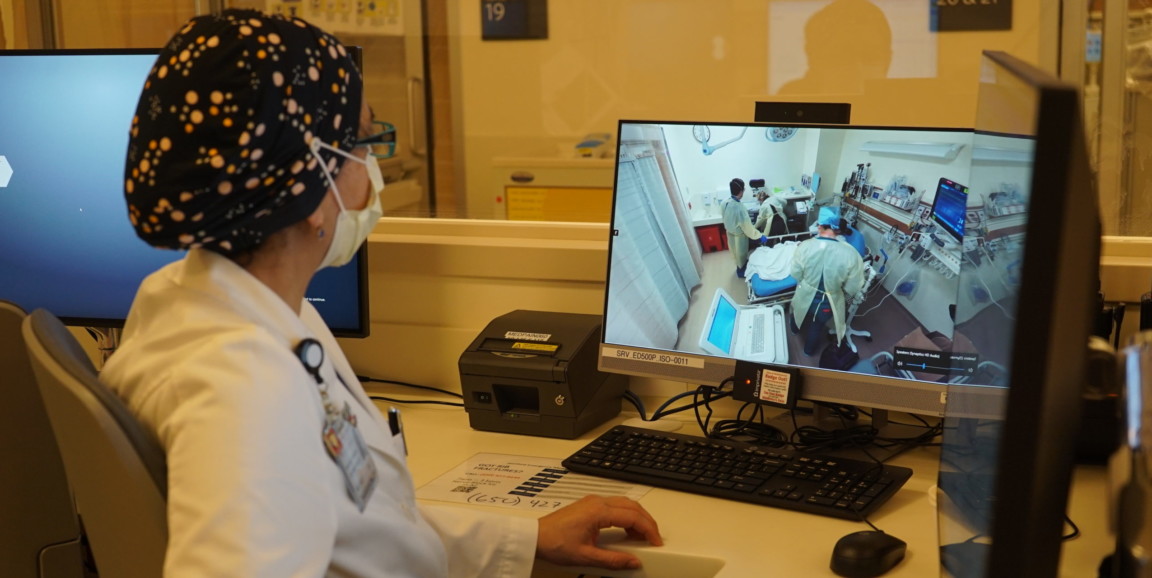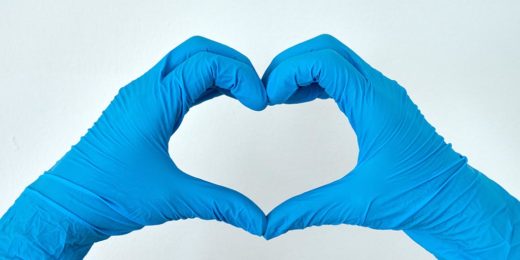COVID-19 has changed our identities as resident physicians to the very core. Seemingly overnight, as the virus spread throughout our community, our workplace transformed from one of comforting familiarity to one with uncertainty and fear for the safety of our patients, our coworkers, our families and ourselves.
Rapid innovation and implementation of technology has allowed us to navigate the challenges from this deadly threat and safely care for our patients.
For years, we have walked through the bustling entrance to Stanford Hospital in the early morning, encountering our coworkers, exchanging pleasantries and finishing an extra large cup of coffee before the shift starts.
These weeks have been different. From the moment you approach the front entrance of Stanford Hospital, it is clear that technology has transformed our typical daily workflow.
Staff line up six feet apart for daily screening. One by one, they snap a photo of a QR code ,which takes them to a screening survey to ensure they are asymptomatic. As they don a face mask, a nurse scans their temperature with an infrared thermometer before they are cleared for work.
Technology in clinical care
As we log onto the computer to virtually care for our patients, we've found ourselves wondering: Is technology removing the very human core of the physician-patient relationship?
What we have seen over these weeks is the very opposite.
In emergency medicine, technology is making it easier to connect with our patients, while protecting both patients and providers and preserving our stores of masks, gowns and gloves.
Using drive-through testing, patients do not have to leave their cars to be evaluated. After registering over the phone, patients connect with physicians via video conferencing while a nurse wearing protective gear obtains their vital signs and collects their nasal swab.
Video monitors in each room in the Marc and Laura Andreessen Emergency Department make it possible to video conference with patients, minimizing the number of health care providers each patient is exposed to. Providers who are at risk themselves, due to medical conditions or for other reasons, can feel more at ease, staying protected from exposure while still caring for their patients.
Once a patient is admitted to the hospital, technology is helping us respond to patient needs.
An artificial intelligence algorithm evaluates numerous clinically relevant parameters from the electronic medical record to identify patients at highest risk for clinical deterioration. These algorithms are being actively tested to see if they can help steer clinicians towards earlier, more aggressive interventions for patients who are most likely to benefit.
In our clinics, visits have been rapidly converted to telehealth. Medical assistants virtually prepare patients -- who are comfortably at home -- for their visits. We have been quickly trained on telemedicine techniques, such as the virtual physical exam, learning how to perform even complex evaluations like a neurologic examination via video remarkably effectively.
The rapid digitization of our workplace extends even to anatomic pathology. Daily discussions of cases that once took place around microscopes with faculty members has now been replaced by video conferencing, as residents and fellows preview their digitized cases remotely. The daily preview of glass slides has also shifted to the digital platform.
Technology is even helping us stay engaged in our learning and maintain our sense of community. Regular town halls held by leaders via video conference keep staff up to date with the latest department and hospital policies and procedures, as well as the latest developments in testing and treatment. To support the wellness of faculty and staff, virtual support groups and happy hours help ensure individuals stay connected, even when quarantined at home between shifts.
Lasting benefits of changes due to COVID-19
The invaluable benefits of this digitization will remain long after this pandemic is over from a clinical care, educational and research standpoint.
During this time of fear and uncertainty, the willingness to rapidly adopt technology has truly been our lifeline. Although the medical community has traditionally been hesitant about major changes in the way we practice, witnessing this response to COVID-19 has only reinforced for us the importance of continuously incorporating new technological innovations in our workplace to provide the best possible care for our patients.
While we may not see that bustling entrance or the smiles of our masked coworkers anytime soon, we rest assured that we can serve our patients safely and effectively through the rapid innovation of technology into our practice.
Swati DiDonato, MD, is a third-year internal medicine resident. Erna Forgó, MD, is a fourth-year anatomic and clinical pathology resident. Haley Manella, MD, is a fourth-year emergency medicine resident. They serve as co-chairs for the Stanford Resident Safety Council, an interdepartmental council of resident and fellow physicians who are engaged in quality improvement and patient safety projects.
Photo by Susan Coppa






